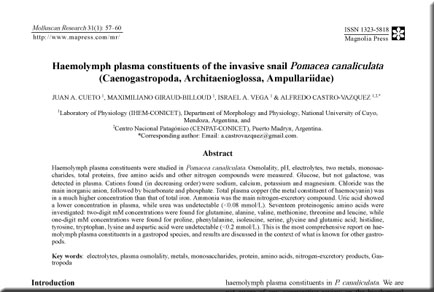Abstract
Haemolymph plasma constituents were studied in Pomacea canaliculata. Osmolality, pH, electrolytes, two metals, monosac-charides, total proteins, free amino acids and other nitrogen compounds were measured. Glucose, but not galactose, was detected in plasma. Cations found (in decreasing order) were sodium, calcium, potassium and magnesium. Chloride was the main inorganic anion, followed by bicarbonate and phosphate. Total plasma copper (the metal constituent of haemocyanin) was in a much higher concentration than that of total iron. Ammonia was the main nitrogen-excretory compound. Uric acid showed a lower concentration in plasma, while urea was undetectable (<0.08 mmol/L). Seventeen proteinogenic amino acids were investigated: two-digit mM concentrations were found for glutamine, alanine, valine, methionine, threonine and leucine, while one-digit mM concentrations were found for proline, phenylalanine, isoleucine, serine, glycine and glutamic acid; histidine, tyrosine, tryptophan, lysine and aspartic acid were undetectable (<0.2 mmol/L). This is the most comprehensive report on hae-molymph plasma constituents in a gastropod species, and results are discussed in the context of what is known for other gastro-pods.

